AGRICULTURAL SCIENCES PAPER 1 GRADE 12 QUESTIONS - AMENDED SENIOR CERTIFICATE EXAMS PAST PAPERS AND MEMOS MAY/JUNE 2018
Share via Whatsapp Join our WhatsApp Group Join our Telegram GroupAGRICULTURAL SCIENCES
PAPER 1
GRADE 12
AMENDED SCE PAST PAPERS AND MEMOS
MAY/JUNE 2018 2018
INSTRUCTIONS AND INFORMATION
- This question paper consists of TWO sections, namely SECTION A and SECTION B.
- Answer ALL the questions in the ANSWER BOOK.
- Start EACH question on a NEW page.
- Number the answers correctly according to the numbering system used in this question paper.
- You may use a non-programmable calculator.
- Show ALL calculations, including formulae, where applicable.
- Write neatly and legibly.
QUESTIONS
SECTION A
QUESTION 1
1.1 Various options are provided as possible answers to the following questions. Choose the answer and write only the letter (A–D) next to the question numbers (1.1.1 to 1.1.10) in the ANSWER BOOK, e.g. 1.1.11 B.
1.1.1 A feeding approach where farm animals have unlimited access to rations, roughage and licks:
- Vitamin provision
- Ad lib
- Natural grazing
- Supplementation
1.1.2 The end products of carbohydrate digestion by micro-organisms in the rumen:
- Amino acids
- Volatile fatty acids
- Ammonia
- Peptides
1.1.3 The term which describes the quantity of feed that is absorbed for maintenance and growth:
- Dry matter
- Nutritive ration
- Feed digestibility
- Feed palatability
1.1.4 The energy value of a feed that is calculated by subtracting energy lost through faeces, urine and gases from gross energy:
- Net energy
- Digestible energy
- Metabolic energy
- Kinetic energy
1.1.5 The following represent the life cycle of a bont tick:
- Larva, nymph and adult are found on separate hosts.
- Larva and nymph are found on one host.
- Larva is found on one host and nymph is found on another host.
- Larva and nymph are found on one host and the adult is found on another host.
1.1.6 Choose ONE description about the flight zone of an animal which is CORRECT:
- A point where a handler will initiate movement
- An area that an animal is not able to see without turning its head
- The space around the animal where it feels safe
- An area where the animal feels threatened
1.1.7 Pigs show the following behaviour when they are under stress:
- Eating hurriedly
- Lying calmly
- Wallow in water
- Biting their tails
1.1.8 Tail docking in sheep is done to …
- make animals ready for agricultural shows.
- improve wool and meat quality directly.
- improve their feed conversion rate.
- prevent blowfly infection.
1.1.9 During the process of spermatogenesis, the following occur:
- Spermatogonia divide during mitosis to form primary spermatocytes.
- Secondary spermatocytes divide during meiosis 1 to form spermatozoa.
- Primary spermatocytes divide through meiosis 1 to form two secondary spermatocytes.
- Spermatids undergo morphological changes to form spermatozoa.
Choose the CORRECT combination:
- (i), (iii) and (iv)
- (ii), (iii) and (iv)
- (i), (ii) and (iii)
- (i), (ii) and (iv)
1.1.10 The oestrus stage in cows where there is rapid development of follicles:
- Met-oestrus
- Pro-oestrus
- Oestrus
- Di-oestrus (10 x 2) (20)
1.2 Indicate whether each of the descriptions in COLUMN B applies to A ONLY, B ONLY, BOTH A AND B or NONE of the items in COLUMN A. Write A only, B only, both A and B or none next to the question numbers (1.2.1 to 1.2.5) in the ANSWER BOOK, e.g. 1.2.6 B only.
COLUMN A | COLUMN B | ||
1.2.1 | A: | Abomasum | Secretion of gastric juice |
B: | Proventriculus | ||
1.2.2 | A: | NR of 1 : 7 | Feed suitable for producing ewes |
B: | NR of 1 : 10 | ||
1.2.3 | A: | Dosing | Appropriate method to control external parasites |
B: | Dipping | ||
1.2.4 | A: | Marbling | The stiffening of muscles in the body of an animal immediately after slaughtering |
B: | Rigor mortis | ||
1.2.5 | A: | Repeat-breeder syndrome | A cow that needs to mate three or more times before it can conceive |
B: | Freemartinism | ||
(5 x 2) (10)
1.3 Give ONE word/term for EACH of the following descriptions. Write only the word/term next to the question numbers (1.3.1 to 1.3.5) in the ANSWER BOOK.
1.3.1 A plan for livestock farmers to ensure that there is enough feed on the farm on an on-going basis to meet animal requirements
1.3.2 A bacterial disease that affects mammary glands
1.3.3 The condition where the testes of male animals remain inside the abdominal cavity
1.3.4 The primary germ layer that surrounds the embryo from which the heart, skeleton and urogenital system develop
1.3.5 The yellow body that is formed in the empty follicle after ovulation, which secretes progesterone (5 x 2) (10)
1.4 Change the UNDERLINED WORD(S) in EACH of the following statements to make it/them TRUE. Write only the answer next to the question numbers (1.4.1 to 1.4.5) in the ANSWER BOOK.
1.4.1 The amount of fat and fat-soluble compounds in a feed is known as nitrogen extract.
1.4.2 Rift Valley Fever is a viral disease that causes blister-like lesions on the tongue and lips.
1.4.3 The inner layer of the uterus is called the myometrium.
1.4.4 Gestation is a prolonged and difficult parturition requiring frequent assistance.
1.4.5 The chorion transports oxygen and nutrients from the mother's blood to the foetus. (5 x 1) (5)
TOTAL SECTION A: 45
SECTION B
QUESTION 2: ANIMAL NUTRITION
Start this question on a NEW page.
2.1 The diagram below represents the alimentary canal of a farm animal. 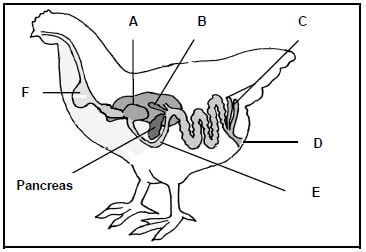
2.1.1 Name parts A, D and F. (3)
2.1.2 Give the importance of parts B and E in the digestion of feed. (2)
2.1.3 Define the concept chemical digestion. (2)
2.2 The flow chart below shows different processes involved in the movement of food through the digestive tract of farm animals. 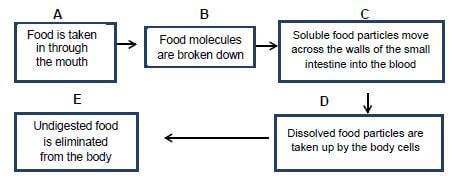
2.2.1 Name processes C, D and E. (3)
2.2.2 Match the descriptions below with the processes in the flow chart above. Write only the letter (A–E) next to the question numbers (2.2.1(a) and 2.2.1(b)).
- Finger-like projections will increase the surface area for nutrient uptake (1)
- Enzyme digestion occurs (1)
2.2.3 Name the enzyme in non-ruminants that is responsible for the digestion of food in A. (1)
2.3 Two feeds are mixed according to the following proportions to obtain a balanced ration to meet the protein need of producing ewes: 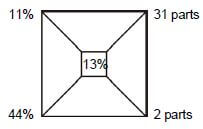
2.3.1 Indicate the parts that represent:
- Maize meal (1)
- Soya beans (1)
2.3.2 Justify the answers to QUESTIONS 2.3.1(a) and 2.3.1(b). (2)
2.3.3 Calculate the quantity of maize meal (in kg) needed to make 285 kg of the mixture. (2)
A dairy farmer keeps a 100 cows on a pasture that supplies a total of 450 000 kg during the rainy season and 216 000 kg during the dry season. The cows are due for calving during the dry months to prevent parasite infestation. The average animal's requirement is 360 000 kg during the rainy season and it increases to 390 000 kg during the dry months due to pregnancy and lactation. Supplementary feeding during the dry months costs a total of R756 000. |
2.4
2.4.1 Calculate the total feed supply (in tons) during the year. (3)
2.4.2 Identify TWO problems of this feed flow programme. (2)
2.4.3 Suggest ONE applicable precautionary measure a farmer needs to take to prevent the problem in QUESTION 2.4.2. (1)
2.5 Name the mineral or vitamin responsible for the following deficiency symptoms:
2.5.1 Parakeratosis in pigs (1)
2.5.2 Pica in cattle (1)
2.5.3 Poor blood clotting in chickens (1)
2.5.4 Night blindness in farm animals (1)
2.6 The graph below shows the feed components of a ration for a farm animal. 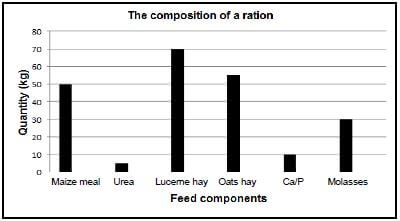
2.6.1 Indicate the type of farm animal that can be fed with this ration. (1)
2.6.2 Support the answer to QUESTION 2.6.1 by giving TWO reasons based on the evidence in the graph. (2)
2.6.3 Identify a concentrate feed in the ration above. (1)
2.6.4 Give TWO reasons for including molasses in this ration. (2) [35]
QUESTION 3: ANIMAL PRODUCTION, PROTECTION AND CONTROL
Start this question on a NEW page.
3.1 The data below shows the production levels of a poultry farm on certain months of the year.
MONTH OF THE YEAR | PRODUCTION (EGGS) (thousand units) | PRODUCTION (BROILERS) (thousand units) |
January | 35 | 20 |
February | 25 | 20 |
March | 40 | 30 |
April | 30 | 40 |
May | 45 | 50 |
June | 50 | 60 |
July | 35 | 60 |
August | 40 | 60 |
3.1.1 Draw a combined bar graph of the egg and broiler production levels on a poultry farm from February to July. (6)
3.1.2 Indicate the trend in broiler production from February to August. (2)
3.2 The pictures below illustrate animal production systems. 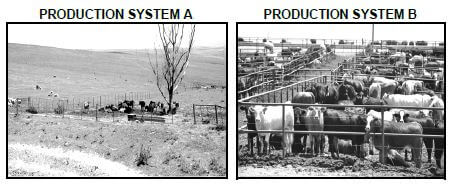
3.2.1 Identify the TWO animal production systems illustrated in the pictures above. (2)
3.3.2 Compare PRODUCTION SYSTEMS A and B on the basis of the following:
- Capital investment (2)
- Area of land in relation to production output (2)
3.3 Name the structure applicable in EACH of the situations below.
3.3.1 Birds are kept to lay eggs for the entire production cycle. (1)
3.3.2 Sows are housed during the late pregnancy period until after giving birth to prevent them from lying on piglets. (1)
3.3.3 Animals are kept at an auction site or just before loading for a short period of time. (1)
3.4 The diagram below indicates various stages of the life cycle of a parasite. 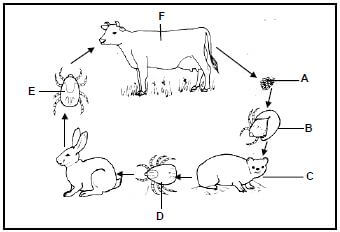
3.4.1 Identify the type of parasite illustrated in the diagram above. (1)
3.4.2 Classify the parasite according to its life cycle as indicated in the diagram above. (1)
3.4.3 Write down the letter (A–F) that represents each of the following stages in the life cycle of the parasite in the diagram above:
- The larvae that hatch from the eggs (1)
- The nymph that will feed on the second host (1)
- The tick that will feed on the third host (1)
3.4.4 Name TWO detrimental effects this parasite could have on livestock. (2)
3.5 Complete the table below by writing the missing information next to the letters (A–E) in the ANSWER BOOK. (Do NOT copy the table.)
DISEASE | CAUSING ORGANISM | SYMPTOMS | TYPE OF ANIMAL |
Avian flu | A (1) | Swelling of the combs and nasal discharge | Poultry |
B (1) | Bacteria | Bloody discharge from the nose, mouth and rectum | C(1) |
D (1) | Protozoa | Froth around the mouth and heart | Cattle |
Lumpy wool | E (1) | Forms a crust on the skin | Wool sheep |
3.6 The picture below shows farm animals consuming a salt lick. Mortalities may occur when there is a high concentration of salt and a shortage of clean drinking water. 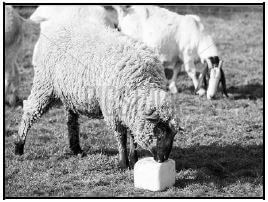
3.6.1 Name the type of poisoning the farm animal above may contract. (1)
3.6.2 Name TWO preventative measures to take in case of the poisoning named in QUESTION 3.6.1. (2)
3.6.3 Indicate a symptom of this type of poisoning in farm animals. (1)
3.6.4 Briefly describe TWO possible measures to treat the poisoning named above. (2) [35]
QUESTION 4: ANIMAL REPRODUCTION
Start this question on a NEW page.
4.1 The diagram below illustrates the reproductive system of a cow. 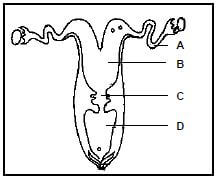
Write down only the letter (A–D) of the part where EACH of the following occurs:
4.1.1 Fertilisation (1)
4.1.2 Implantation of the fertilised ovum (1)
4.1.3 Deposition of semen by a male organ (1)
4.2 The diagram below illustrates the role of hormones in the development and functioning of organs in the female animal. 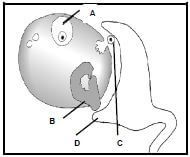
4.2.1 Name parts A and C. (2)
4.2.2 Indicate the hormone that:
- Stimulates the growth and development of part A (1)
- Is produced by part B (1)
4.2.3 State the function of part D. (1)
4.3
A female animal is treated with hormones to make her super-ovulate. The eggs are fertilised and the embryos are removed and placed into another female animal. |
4.3.1 Identify the reproductive process above. (1)
4.3.2 State TWO advantages of the reproductive process identified in QUESTION 4.3.1 to farmers. (2)
4.3.3 Give the term for a cow that has undergone the following procedures:
- Treated with hormones to super-ovulate (1)
- Placement of an embryo (1)
4.4 Artificial insemination (AI) is a technique used by farmers to improve the quality of their livestock.
4.4.1 Indicate TWO characteristics of high quality semen for successful insemination. (2)
4.4.2 Give the function of EACH of the following dilutants of semen:
- Fructose (1)
- Glycerol (1)
- Antibiotics (1)
4.4.3 Name TWO disadvantages of AI. (2)
4.4.4 Name TWO congenital defects in bulls that can lead to unsuccessful fertilisation. (2)
4.5 The diagram below shows a developing embryo. 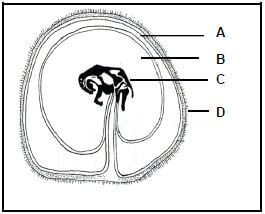
4.5.1 Identify membranes A and D. (2)
4.5.2 State TWO functions of fluid B. (2)
4.5.3 What is the role of membrane D? (1)
4.5.4 Indicate the last stage of pregnancy. (1)
4.6 The graph below illustrates the milk production of a dairy cow. 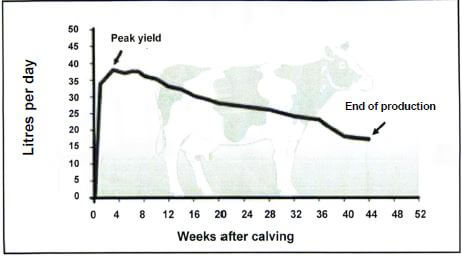
4.6.1 Identify the process illustrated above. (1)
4.6.2 Use the information in the graph and give the time (in weeks) when the following occurred:
- Drying off of the cow (1)
- Calving (1)
- Peak of milk production (1)
4.6.3 Name THREE factors that will influence the quantity of milk produced during the peak production period of the cow. (3) [35]
TOTAL SECTION B: 105
GRAND TOTAL: 150